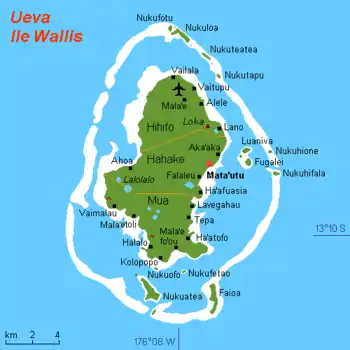Talietumu
Talietumu or Kolo Nui[1] is an archaeological site in Wallis and Futuna in the southwestern part of the Pacific Ocean.


Site
Talietumu is situated about 9 km (5.6 mi) southwest of the capital of Mata-Utu and northeast of Halalo in the Mu'a district on Wallis Island (Uvea) (2).
The site was a fortified Tongan settlement called Kolo Nui (3) and the whole fortress is surrounded by a strong defensive wall build of basalt with several entrances.[2] Inside the fort there are a few preserved buildings and structures, lawns and the central elevated platform called Talietumu (a Marae or Mala´e, "Sacred Place") (4). The platform is of circular prolonged shape upon a circular stockade base.[1] Raised walkways paved in stone start from the mala'e and radiate outward from within the fort.
History
The fort was built around 1450 during the expansion of the Tu'i Tonga Empire and it was the last holdout of the Tongans on Uvea until they were defeated.
French archaeologists Daniel Frimigacci, Jean-Pierre Siorat and Maurice Hardy of the French CNRS (Centre national de la recherche scientifique) spent several years restoring the central platform using original techniques and completed that work around 1997. The platform now measures about 5 meters in height and about 80 m in length.[1]
Today the ruins of the fortress are a popular tourist attraction.[3]
References
- Christophe Sand (2004). "The input of francophone archaeological research in the Pacific: A short summary" (PDF). The Journal of Pacific Studies. 27 (1): 1-12. Retrieved 27 January 2021.
- "Talietumu Fort, Wallis and Futuna: The Fortress for a King Whose Feet Could Never Touch the Ground". Ancient Origins. Retrieved 27 January 2021.
- "15th Century Tongan Fortress Is Tourist Attraction In Wallis". Pacific Islands Report. 14 January 2014. Retrieved 27 January 2021.